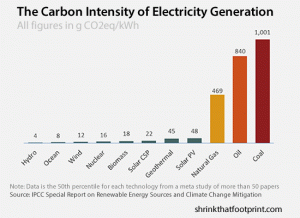Is Photovoltaic Energy better than BC’s Grid?
Posted by karen in Front, News, Our News, on November 5, 2014Often we are asked if it makes sense to install solar energy when we live in area where our electricity is primarily hydro power – a fairly “green” energy source.
An IPPC study found that Solar Photovoltaic (PV) energy has a carbon intensity of 48 g CO2e / kWh. This figure includes full life-cycle emissions. This is only slightly higher than geothermal which is 45 and is often promoted in BC. PV has the advantage of being located at or near the energy consumption location so there would be additional life-cycle emissions associated with transmission infrastructure for geothermal.
BC grid electricity consists of electricity generated in BC which is about 92% hydroelectricity plus imports from Alberta and other jurisdictions that use coal. If we assume 7% of is imports, the net result is 86% hydro (92% of 93%). We further assume 1% wind, 6% natural gas and 7% coal we have a weighted intensity of 102 g CO2/kWh using the same IPPC numbers.
This number is similar to what NRCan (Natural Resources Canada) has used in the RETScreen software for the BC Grid.
That means that for every kWh that PV produces in BC it cuts GHG emissions by about half.
The Pacific Institute of Climate Studies (PICS) estimates the GHG life cycle analysis intensity of the BC electrical grid is closer to 140 g. Based on this the reduction from photovoltaics would be even greater.
That doesn’t mean that PV is always a better alternative than the grid. Some sites that have poor a solar resource (due to shading or azimuth of the available mounting surfaces). There are also poorly designed systems that fail to preform optimally. If they are doing so at less the 50% of potential production then they may be net negative from a GHG perspective.
It is also important to remember that BC is part of a larger grid that connects western Canada the US and part of Mexico. If we are able to generate more renewable energy here we can export that to other regions and reduce their dependence on coal-fired power. And PV production works especially well with large hydro dams which can be more quickly adjusted to changes in demand and non-firm production.
Note:Often the CO2e intensity for BC Electricity is shown to be lower than the 103.7 g CO2/kWh we are using here. However, those numbers generally are just looking at the generation of power in BC rather than the intensity of the power consumed in BC.
Sources:
IPCC Study: http://srren.ipcc-wg3.de/report/IPCC_SRREN_Annex_II.pdf
PICS Study: https://pics.uvic.ca/sites/default/files/uploads/publications/Lifecycle%20analysis%20of%20GHG%20intensity%20in%20BC%27s%20energy%20sources%20.pdf




